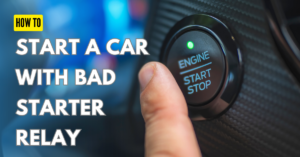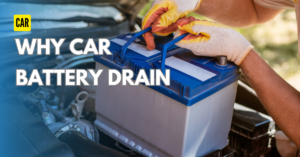Bump-starting relies on the rolling motion of the car’s wheels, which is transmitted through the transmission to spin the engine. This action helps draw in air and fuel, ultimately starting the engine when there’s not enough battery power to operate the starter motor. It’s important to note that this method is typically applicable only to vehicles with manual transmissions. The steps to bump start are as follows:
- Step 1 : Prepare the Vehicle
- Step 2 : Start Rolling
- Step 3 : Build Momentum
- Step 4 : Pop the Clutch
- Step 5 : Idling

What is Bump Starting ?
Bump-starting a car, also known as push-starting or roll-starting, is a method used to start a vehicle with a dead battery. It’s colloquially called “popping the clutch” because it involves releasing the clutch pedal abruptly.
When to Bump Start a Car ?
If your car battery has been drained due to various reasons, you might find yourself in a situation where you need to start your car even with a dead battery. In such cases, knowing how to start a car with a dead battery is crucial.
Bump-starting is one method to start a car with a dead battery. However, it involves specific procedures and safety precautions. It’s crucial to understand and follow the correct steps for your particular situation to ensure a successful bump start.
Before attempting a bump start, it’s advisable to confirm that the car is not starting due to a low or dead battery. Test the battery to verify if it is, indeed, low or dead.
How To Test a Car Battery ?
A car battery can be tested to determine if it’s dead or not. There are two ways to test a car battery:
- Test with a Multimeter: Use a multimeter to check the voltage of the car battery terminals. A healthy battery should read around 12 volts.
- Test Without a Multimeter: If you don’t have a multimeter, you can often gauge the battery’s condition based on the several indicators.
Checking for corrosion on the car battery terminals is also crucial. Corrosion can disrupt the electrical power supply to the starter, mimicking the symptoms of a low or dead battery. If your car is not starting due to corroded terminals, simply cleaning the battery terminals can often resolve the issue.
How To Bump Start Your Car ?
Before attempting a bump start, it’s essential to be aware of a few key points.
- Clear the Surrounding: When attempting a bump start, remember that you’ll need to steer the car with limited power steering. Therefore, avoid trying to bump start in crowded areas or around tight corners for safety reasons.
- Be prepared to engage the parking brake in case of an emergency. When the car is off, there won’t be any brake assistance, and the brake pedal will be very stiff, making it difficult to stop the car using the foot brake. In such a situation, the parking brake becomes your primary option for stopping the car.
- Always have someone present to control the vehicle while pushing it. This person can help steer and maintain control of the car during the bump start process.
Here are the step-by-step instructions with infographics on how to correctly bump start a car:
Step 1 : Prepare the Vehicle
- Ensure that the ignition is turned to the “on” position.
- Disengage the parking brake
- Engaging the car in 2nd gear is essential as it makes it easier to spin the engine by rolling the car. However, depending on the specific vehicle, 1st gear alone might be sufficient for push starting. It’s essential to consider your car’s requirements when choosing the gear.
- Depress the clutch fully: This action disengages the transmission from the engine, allowing the wheels to spin freely.
Step 2 : Start Rolling
You can start rolling using any one of the following methods:
- Having someone push the car manually.
- Rolling down a slope.
Step 3 : Build Momentum
- Let the vehicle accelerate to a speed of 5-10 mph.
Step 4 : Pop the Clutch
- Release the clutch abruptly (pop the clutch), and the car’s engine will engage, start spinning, and give a jerk. With any luck, the car may start.
Step 5 : Idling
- As soon as the car starts, press the clutch pedal again to prevent a stall.
- Ease on the brake to bring the car to a stop.
- Put the car in neutral position
Why won’t My Car Jump Start ?
If a car still won’t start after attempting a bump start, there could be various reasons behind it. The specific cause for a car not starting depends on the symptoms it’s exhibiting. Generally, a car can show two primary symptoms: it’s either cranking but not starting, or it’s not cranking and not starting at all. In both cases, diagnosing and resolving the issue may involve inspecting different systems.
- No cranking at all: If the car doesn’t make any noise when you turn the key (no cranking), there could be problems with faulty wiring, blown fuses, or other electrical issues, as well as sensor malfunctions.
- Cranking But Won’t Start: If the car cranks but doesn’t turn over and start, this could be indicative of problems with the fuel system. Issues with the fuel pump, fuel pump relay, or fuel pump fuse, as well as ignition problems, could be the culprits.
Conclusion
If your car is not starting due to a low or dead battery, you can get it up and running by bump-starting the vehicle. bump-starting a vehicle is a useful skill, but it must be carried out safely and correctly.


